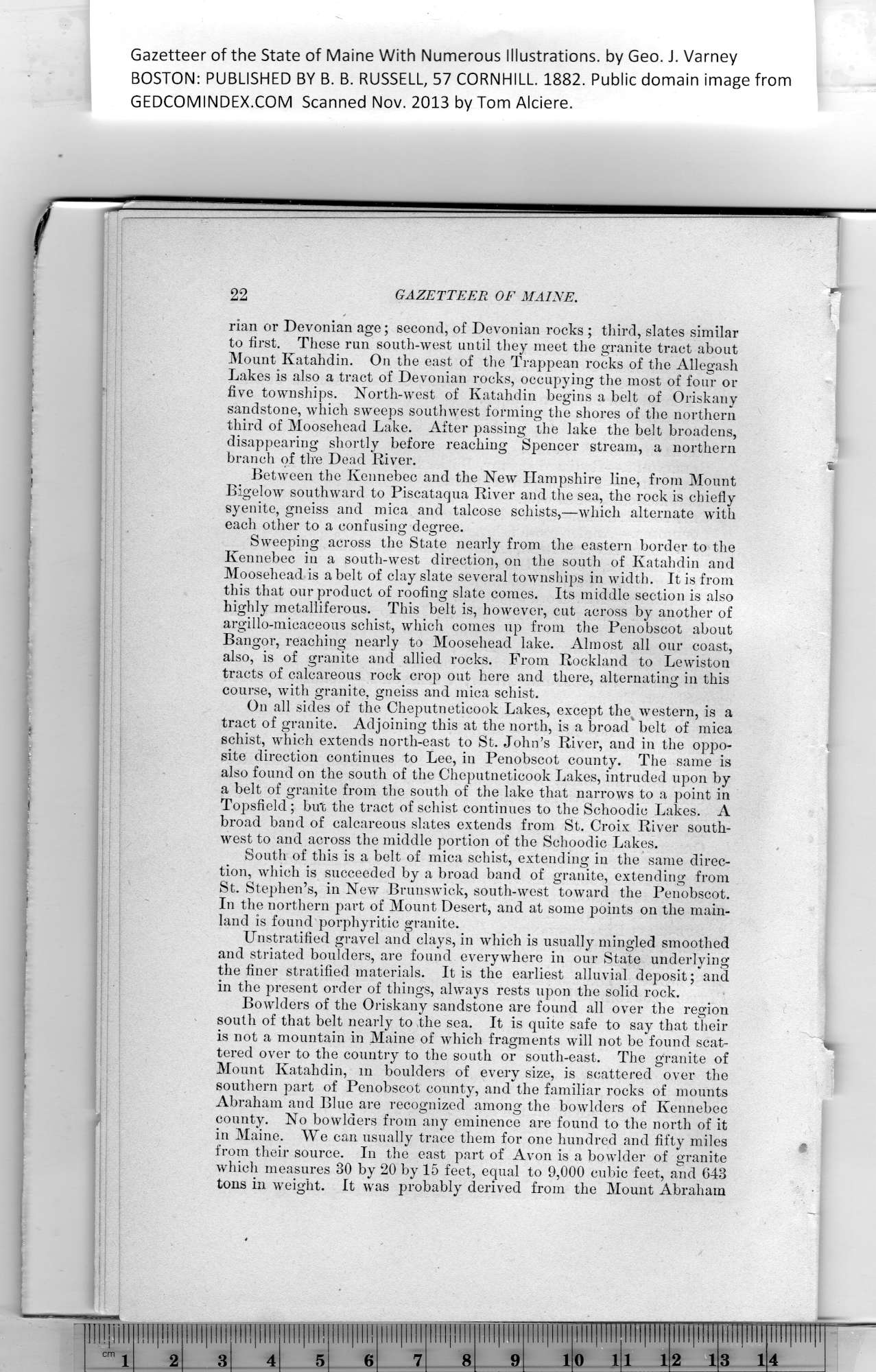|
Gazetteer of the State of Maine With Numerous Illustrations, by Geo. J. Varney
BOSTON: PUBLISHED BY B. B. RUSSELL, 57 CORNHILL. 1882. Public domain image from
22 GAZETTEER OF MAINE.
rian or Devonian age; second, of Devonian rocks ; third, slates similar
to first. These run south-west until they meet the granite tract about
Mount Katahdin. On the east of the Trappean rocks of the Allegash
Lakes is also a tract of Devonian rocks, occupying the most of four or
five townships. North-west of Katahdin begins a belt of Oriskany
sandstone, which sweeps southwest forming the shores of the northern
third of Moosehead Lake. After passing the lake the belt broadens,
disappearing shortly before reaching Spencer stream, a northern
branch of the Dead River.
Between the Kennebec and the New Hampshire line, from Mount
Bigelow southward to Piscataqua River and the sea, the rock is chiefly
syenite, gneiss and mica and talcose schists,—which alternate with
each other to a confusing degree.
Sweeping across the State nearly from the eastern border to the
Kennebec in a south-west direction, on the south of Katahdin and
Moosehead is a belt of clay slate several townships in width. It is from
this that our product of roofing slate comes. Its middle section is also
highly metalliferous. This belt is, however, cut across by another of
argillo-micaceous schist, which comes up from the Penobscot about
Bangor, reaching nearly to Moosehead lake. Almost all our coast,
also, is of granite and allied rocks. From Rockland to Lewiston
tracts of calcareous rock crop out here and there, alternating in this
course, with granite, gneiss and mica schist.
On all sides of the Cheputneticook Lakes, except the western, is a
tract of granite. Adjoining this at the north, is a broad belt of mica
schist, which extends north-east to St. John’s River, and in the oppo-
site direction continues to Lee, in Penobscot county. The same is
also found on the south of the Cheputneticook Lakes, intruded upon by
a belt of granite from the south of the lake that narrows to a point in
Topsfield; but the tract of schist continues to the Schoodic Lakes. A
broad baud of calcareous slates extends from St. Croix River south-
west to and across the middle portion of the Schoodic Lakes.
South of this is a belt of mica schist, extending in the same direc-
tion, which is succeeded by a broad band of granite, extending from
St. Stephen’s, in New Brunswick, south-west toward the Penobscot.
In the northern part of Mount Desert, and at some points on the main-
land is found porphyritic granite.
Unstratified gravel and clays, in which is usually mingled smoothed
and striated boulders, are found everywhere in our State underlying
the finer stratified materials. It is the earliest alluvial deposit; and
in the present order of things, always rests upon the solid rock.
Bowlders of the Oriskany sandstone are found all over the region
south of that belt nearly to the sea. It is quite safe to say that their
is not a mountain in Maine of which fragments will not be found scat-
tered over to the country to the south or south-east. The granite of
Mount Katahdin, m boulders of every size, is scattered over the
southern part of Penobscot county, and the familiar rocks of mounts
Abraham and Blue are recognized among the bowlders of Kennebec
county. No bowlders from any eminence are found to the north of it
in Maine. We can usually trace them for one hundred and fifty miles
from their source. In the east part of Avon is a bowlder of granite
which measures 30 by 20 by 15 feet, equal to 9,000 cubic feet, and 643
tons in weight. It was probably derived from the Mount Abraham
PREVIOUS PAGE ... NEXT PAGE
This page was written in HTML using a program written in Python 3.2
|
